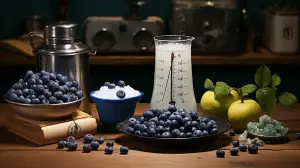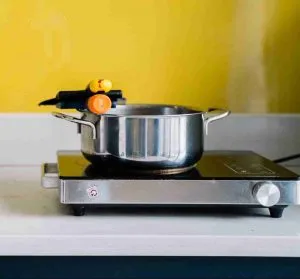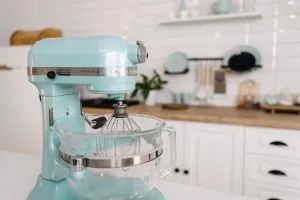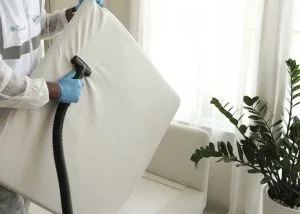Ever wondered if your beloved ceramic dish could survive a bake in the oven? With so many types of ceramics out there — from earthenware to porcelain — it’s not always easy to figure out which ones can withstand high temperatures.
In this article, we’ll help you understand how to determine whether your ceramic kitchenware is oven-safe and provide useful tips on baking with those that are. Read on for a safer, more efficient time in the kitchen!
Contents
ToggleKey Takeaways
- Ceramic can go in the oven if it is marked as oven-safe, but not all ceramics are safe for high temperatures.
- Types of ceramic-like earthenware, stoneware, and porcelain have different heat tolerances in the oven.
- To check if a ceramic dish is oven-safe, you can perform the water cup test by heating both the cup and the dish together in the microwave.
- Using non-oven-safe ceramic in the oven can be risky and may cause cracking or breaking. It’s important to use dishes specifically made for high temperatures.
- Proper care for ceramic ovenware includes gentle cleaning with mild soap and avoiding sudden temperature changes. Handling with care and using appropriate utensils will also help prevent damage.
Understanding Ceramic

Ceramic is a non-metallic mineral substance that is made by molding clay and then firing it at high temperatures.
Types of Ceramic
Ceramics comes in many types. The first type is earthenware. It is cheap, but it needs to be glazed because it is not oven-safe on its own. Stoneware is the second type. It is tough and thick. This type can stand high heat, even without a glaze. The third type is porcelain. It costs a lot and is very tough. But, not all porcelain dishes can go in the oven safely. These are the three ceramic types used to make kitchen goods like pots, pans, and dishes.
Is Ceramic Oven-Safe?
Ceramic can be oven-safe. This means some dishes can be used in the oven without breaking or melting. But, not all ceramics are safe for ovens. The type of ceramic and how it’s made plays a big part.
For example, earthenware, stoneware, and porcelain are types often found in kitchenware.
Earthenware may crack under high heat temperatures. Stoneware is strong and dense; it does well with lofty temperatures even without a glaze. Porcelain also withstands heat well but might need special care to avoid cracking.
Dishes marked as ‘oven-safe’ have coatings that make them good for cooking at hot temps!
Discover which pans are safe to use in the oven.
Can Ceramic Go in the Oven?

Does ceramic have the ability to withstand the heat of an oven?
Knowing the Type of Ceramic
Ceramic comes in three types used to make kitchen tools. These are earthenware, stoneware, and porcelain. Earthenware is often not safe for the cooker unless it has a glaze on it. Not all dinner plates or bowls made of porcelain can be put in the oven.
They must have a mark showing they are oven-secure. Knowing what kind of ceramic you have is key if you want to use them in the oven!
The Thickness Theory
The thickness of ceramic plays a big role in its oven safety. Thin ceramics can crack when they meet elevated temperatures. On the other hand, thick ceramics are less likely to break from heat exposure because they evenly spread out the heat.
Stoneware, a kind of ceramic known for its dense and durable qualities, is great at standing up to lofty temperatures. It’s not just about what the dish is made from but also how it’s made that makes it safe for your cooker!
How to Check if Ceramic is Oven-Safe

To determine if the ceramic is oven-safe, perform the water cup test.
The Water Cup Test
To determine if a dish is microwave-safe, you can perform the water cup test. Here’s how to do it:
- Fill a microwave-safe cup with water.
- Place the cup next to the pottery dish in the microwave.
- Heat both the cup and the dish together for a short amount of time.
- After heating, carefully check the temperature of the cup and the dish.
- If the water in the cup becomes hot but the dish remains cold, it means that the dish is microwave-safe.
- However, if the dish becomes hot while the water remains cold, it suggests that the dish is not microwave-safe.
- You can repeat this test for different pottery dishes to make sure.
Benefits and Dangers of Baking with Ceramic

Ceramic cookware offers health benefits and possible risks. Discover why it’s important to choose oven-safe ceramic and how to bake with it safely. Read more to ensure a delicious and safe cooking experience.
Health Benefits
Oven-safe pottery dishes offer health benefits because they are made with a non-reactive and toxin-free ceramic coating. This means that when you cook or bake with them, there is no risk of harmful chemicals leaching into your food.
Additionally, ceramic cookware is known for its heat conduction properties, which ensures even cooking and prevents hot spots. This can help you maintain the nutritional value of your food while also reducing the need for excessive oil or butter in your recipes.
So not only can you enjoy delicious meals cooked in oven-safe dishes, but you can also feel good about the health benefits they provide.
Possible Risks
Using non-oven-safe ceramic in the oven can be risky. When you put ceramic that is not meant for high heat temperatures into a hot cooker, it can crack or even break. This could create a big mess and might even damage your oven.
So, it’s important to make sure you have oven-safe ceramic before baking or cooking with it in the oven. It’s safer to use pottery plates that are specifically made to withstand the maximum temperatures of an oven so you don’t have to worry about any accidents happening.
Proper Care for Ceramic Ovenware
To keep your ovenware in top shape, it’s important to follow proper care guidelines. This includes using gentle cleaning methods and avoiding any potential damage. Discover the best practices for maintaining your kitchenware to ensure its longevity and continued functionality.
Cleaning Tips
Here are some tips for cleaning your ovenware:
- Wait for it to cool: Let your dish cool down before cleaning it. This will prevent any potential damage or cracking.
- Use gentle soap and a soft sponge: Wash the dish with mild soap and warm water using a soft sponge or cloth. Avoid using abrasive cleaners or scrub brushes, as they can scratch the surface.
- Soak tough stains: If you have stubborn stains on your dish, soak it in warm soapy water for a few minutes before scrubbing gently.
- Avoid drastic temperature shifts: Don’t go from extreme hot to cold (or vice versa) too quickly when cleaning your pottery. This can cause thermal shock, leading to cracks or breakage.
- Dry thoroughly: After washing, make sure to dry your dishes completely before storing it. Moisture can lead to mold growth or create an environment for bacteria.
Avoiding Damage
To avoid damaging your ceramic ovenware, follow these tips:
- Handle with care: Be gentle when placing or removing dishes from the oven to prevent dropping or banging them against other objects.
- Avoid sudden temperature changes: Do not expose hot pottery to cold surfaces or water, as this can cause thermal shock and lead to cracking or breaking.
- Let it cool down: Allow them to cool before cleaning them or placing them in the fridge. Sudden temperature changes can weaken the structure of the pottery and make it more susceptible to damage.
- Use appropriate utensils: When serving or stirring food in pottery, use silicone, wood, or plastic utensils instead of metal ones that could scratch or chip the surface.
- Cook on medium or low heat: While ceramic is heat-resistant, it’s best to cook on medium or low heat settings rather than maximum temperatures, which can increase the risk of damage.
- Clean gently: Use mild dish soap and a soft sponge or cloth to clean your ovenware. Avoid abrasive cleaners or scrub brushes that could scratch the surface.
- Store carefully: When storing your dishes, place protective padding or towels between them to prevent them from knocking against each other and potentially breaking. Learn how to handle oven spills and other oven-related issues.
Conclusion
In conclusion, ceramic can be put in the oven if it is marked as oven-safe. It’s important to know the particular type you’re using and to check for oven-safe labels or symbols. Taking proper care of your pottery will ensure it lasts a long time and serves you well in the kitchen.
So go ahead and enjoy baking with your favorite cookware!
FAQs
1. Can all ceramic items can be put in the oven?
Not all ceramics can survive in the oven. Look for labels on products like bowls, cups, and mugs that say “oven-safe” or have an oven sign that reminds of wavy lines. Usually, you can find them on the bottom of the bowl.
2. How do I know if my ceramic bowl is safe to use in an oven?
Check for an oven safe mark or label on your cookware or dishes including pots and pans. Brands such as Corelle, Bentgo, Bruntmor, Sweese are often known for their oven-safe items.
3. What happens if a non-oven-proof ceramic plate goes into the oven?
If not marked as “oven-proof” then ceramics could shatter when heated too high due to crazing and glazing cracks which can be daunting!
4. What kind of ceramics should I look out for food safety?
Pottery whitewares like dinner plates or bowls without toxic glazed coatings containing cadmium are safe. Also look at brands with non-reactive coating such as Le Creuset.
5. Are other types of cooking equipment also made from Ceramic?
Yes! Apart from traditional earthenware, you have options like the GreenPan SearSmart Cookware Set which is non-stick and scratch-resistant.
6. Can I just move my dish straight from the fridge to a hot Oven?
No! It’s important never to put very cold fridge-cold ceramics directly into hot cookers. This sudden change in temperature can cause them to shatter because they are brittle.























































